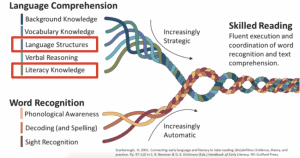In connection with the Science of Reading Virtual Summit, Waterford.org is sharing an article series exploring the science behind how students learn to read and what administrators can do to guide school and classroom strategies.
Sign up for the free summit to learn research-based strategies from early education experts, including Julie Christensen, Vice President of Curriculum at Waterford. Plus, find upcoming and on-demand video series led by early education experts through the Webinar Library, featuring topics chosen with administrators in mind, like:
- Impactful Family Engagement Made Easy
- Understanding the Six Literacy Strands
- Improving Student Outcomes with Professional Services
The human brain is pre-wired for speech, but learning to read always involves explicit instruction. “Learning to read requires several years of intentional instruction,” explains Waterford Director of Curriculum Julie Christensen in a recent video. And the earlier that children are introduced to the foundational skills for reading, the better.
Experts have disagreed in the past on what this explicit instruction should look like. This argument was popularized as “the Reading Wars.” Some educators preferred a systematic approach based on phonics and decoding instruction, while others favored providing students with whole-language reading lessons focused on comprehension.
Today, educators know that both elements are essential. Students need explicit phonological awareness and phonics instruction to build word recognition skills. Immersive experiences that foster language comprehension are equally important for young learners.
Discover how the early learning nonprofit Waterford.org aligns with these findings to provide explicit, adaptive reading instruction for PreK-2nd grade learners.
Waterford.org Curriculum Aligns with the Science of Reading
Waterford.org is a nonprofit with a mission to provide equitable and accessible learning curriculum to PreK-2 students. As a leader in early education, Waterford includes recent findings on the science of reading in the design of our early reading programs.
Waterford’s supplemental literacy curriculum is organized around six instructional strands that align with research conducted by the National Reading Panel:
- Phonological awareness
- Phonics
- Reading fluency
- Reading comprehension and vocabulary
- Language concepts
- Communication
These strands also match with two popular frameworks of how children learn to read: the Simple View of Reading and Scarborough’s Reading Rope.
The Simple View of Reading explains that proficient reading is the product of word recognition and language comprehension skills. Phonological awareness and phonics foster reading fluency. Language comprehension enables students to use and understand language so they can engage with and respond to texts on a deeper level.
Waterford’s instructional strands also line up with Scarborough’s Reading Rope. This framework defines sub-skills, explaining how each of the two main factors contribute to growth for automatic and strategic reading.
Waterford Reading Academy: Support and Engagement for All Learners
Educational research shows that as little as 5% of children learn to read in a seemingly effortless manner. For approximately two-thirds of children, instruction based on the science of reading is essential to their success. The remaining children also benefit from research-based instruction.
Waterford Reading Academy is a supplemental early education program for PreK-2nd grade that engages learners with adaptive instruction, empowers families in their child’s educational journey, and equips educators with the data they need to inform instruction.
 Waterford Reading Academy curriculum adapts to individual needs, meeting students where they are in their reading, math, and science abilities. This allows students to focus on areas where they need the most help to turn weaknesses into strengths. Lessons and activities are all designed to be engaging for PreK and early elementary students, with developmentally appropriate instruction, colorful graphics, and easy navigation.
Waterford Reading Academy curriculum adapts to individual needs, meeting students where they are in their reading, math, and science abilities. This allows students to focus on areas where they need the most help to turn weaknesses into strengths. Lessons and activities are all designed to be engaging for PreK and early elementary students, with developmentally appropriate instruction, colorful graphics, and easy navigation.
Waterford Reading Academy also offers personalized support for English language learners. Instructions and scaffolded support are available in English and Spanish.
Families are empowered through regular updates on their child’s progress towards their goals, allowing them to stay informed and engaged. Waterford also provides access to thousands of home learning resources available in English and Spanish.These include personalized academic and mindset activities to support young learners beyond the program itself.
Sign up for the Science of Reading virtual summit to learn how Waterford’s early reading programs can benefit the children in your community and classrooms.
This article is the first in a two-part series on the research and impact of Waterford programs. To read part one, which explores proven impact of Waterford’s reading programs, visit How Science of Reading Research Affirms the Impact of Waterford’s Evidence-Based Reading Intervention Program.



